| Article ID | Journal | Published Year | Pages | File Type |
|---|---|---|---|---|
| 3897237 | Seminars in Nephrology | 2012 | 8 Pages |
SummaryOnce an arteriovenous fistula is established, the blood vessels are subjected to marked changes in hemodynamic forces that trigger remodeling to re-establish baseline parameters of sheer and hoop stress. These homeostatic processes culminate in two requirements that define an adequate and enduring access. First, blood flow must increase to provide amounts that will provide adequate delivery of blood to the artificial kidney. Second, the vessel wall must undergo changes that will allow it to withstand repeated cannulation. Hence, a fistula is mature when it can do what it sets out to do (flow readiness) despite what is being done to it (cannulation readiness). Although flow has been measured with Doppler, high-frequency ultrasound is needed to measure vessel wall thickness to determine hoop stress. Beyond the wall of the vessel, the concept of cannulation readiness depends on the skill and expertise of the cannulator.
